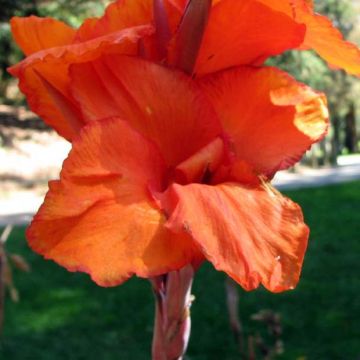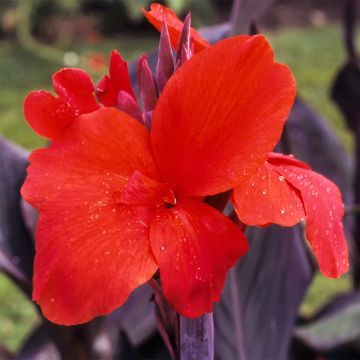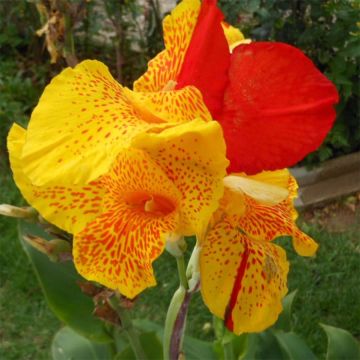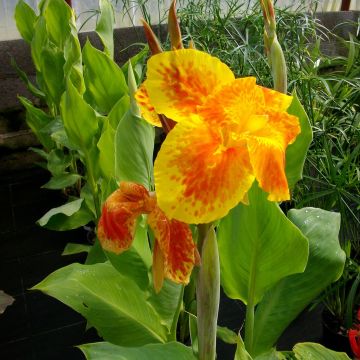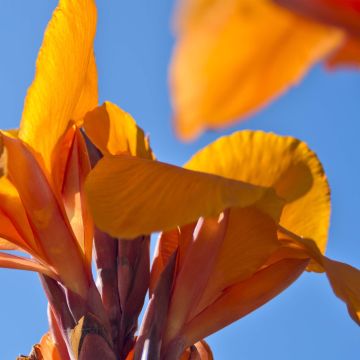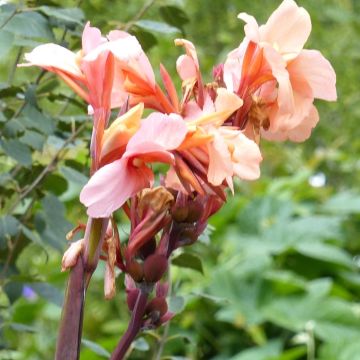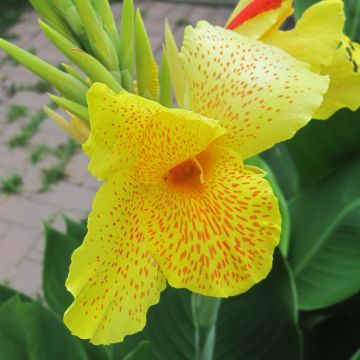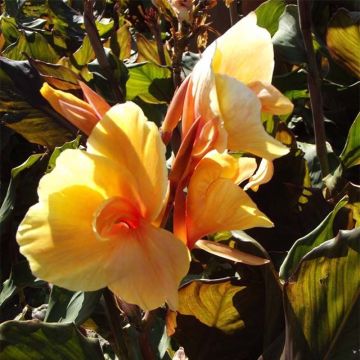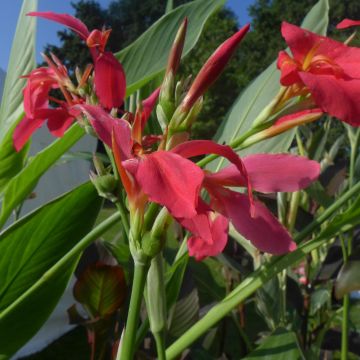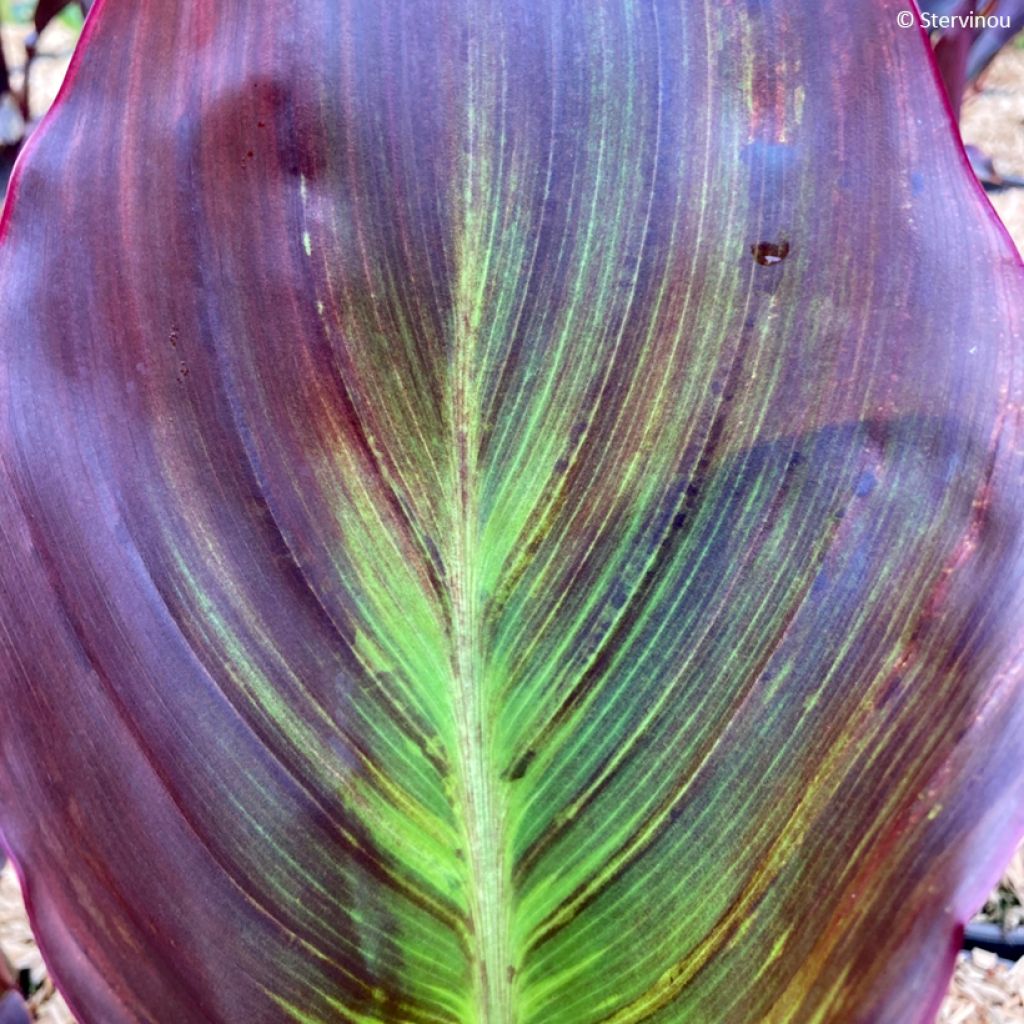

Canna Black Cleopatra - Indian shot
Canna Black Cleopatra - Indian shot
Canna Black Cleopatra
Indian shot, Canna, Cann Lily, African Arrowroot, Edible Canna, Purple Arrowroot, Sierra Leone Arrowroot
This item cannot be shipped to the selected country
Delivery charge from €5.90
More information
Schedule delivery date,
and select date in basket
This plant carries a 12 months recovery warranty
More information
We guarantee the quality of our plants for a full growing cycle, and will replace at our expense any plant that fails to recover under normal climatic and planting conditions.
From €5.90 for pickup delivery and €6.90 for home delivery
Express home delivery from €8.90.
Does this plant fit my garden?
Set up your Plantfit profile →
Description
The Canna 'Black Cleopatra' boasts a beautiful chocolate-purple foliage and bright red flowers from summer to autumn. It is a superb plant, perfect for exotic borders, but also for creating large pots on the terrace. Like all cannas, this variety is slightly hardy. Outside the mildest winter regions, its rhizomes should be unearthed in autumn and stored in a dry and cool place during winter.
The Canna (x) generalis 'Black Cleopatra' is a horticultural selection by Ernest Turc (France). It is a variant of the cultivar 'Cleopatra' with broad burgundy to brown leaves, producing an abundance of red flowers striped with yellow towards the throat. Like all cannas, this plant belongs to the family of Cannaceae, in the same group as gingers (Hedychiums) and banana trees.
From a thick and knotty rhizome emerges in spring a well-dense clump, composed of numerous large and wide lanceolate entire leaves. Their colour ranges from yellowish-green striped with brownish-purple to almost uniform deep purplish-burgundy in full sun. Thin flowering stems reaching a height of 1.20 m emerge from the foliage, from July until frost if care is taken to regularly prune the faded flowers before fruit formation. The asymmetrical flowers with shiny petals are clustered in dense spikes in the upper part of the stems. The canna's vegetation is deciduous, its beautiful leaves dry in winter. The stump can withstand short frosts of about -4°C in not too wet soil.
The Cannas are ideal plants to bring a touch of exoticism and lushness to summer borders. Plant them in groups of about ten rhizomes, of the same variety or mixing foliage and flower colours. The Canna 'Black Cleopatra' allows for easily creating large lush pots on the terrace or balcony. Very ornamental when placed alone, it will be enhanced by the presence of common castor beans or compact Colocasias like 'Sangria'. Cultivate this plant like a Dahlia, unearth the rhizomes before frost to replant them in spring.
Report an error about the product description
Flowering
Foliage
Plant habit
Botanical data
Canna
Black Cleopatra
Cannaceae
Indian shot, Canna, Cann Lily, African Arrowroot, Edible Canna, Purple Arrowroot, Sierra Leone Arrowroot
Cultivar or hybrid
Other Cannas
Planting and care
The Canna 'Black Cleopatra' does not like the cold and must spend the winter sheltered from frost. Its flowering will be more beautiful if planted in the sun. When planting in the ground, it should only be done after the last frosts. It will also need to be stored away at the first frosts, to keep the rootstock dry and cool, in a bit of turf for example. Plant them in moist, but well-drained soil (if needed, lighten your soil with some turf or sand). Cover with 5 cm of soil, and keep a spacing of 40 cm between the bulbs. Make an organic fertiliser contribution at planting and at least once a month. Water regularly throughout the growing and flowering season, ensuring the soil never completely dries out. You can also speed up the cycle of cannas by planting them as early as February in a frost-free sheltered pot, to transplant them to the garden in the warmer days (May-June in the north of France, mid-April in the south).
Planting period
Intended location
Care
This item has not been reviewed yet - be the first to leave a review about it.
Haven't found what you were looking for?
Hardiness is the lowest winter temperature a plant can endure without suffering serious damage or even dying. However, hardiness is affected by location (a sheltered area, such as a patio), protection (winter cover) and soil type (hardiness is improved by well-drained soil).

Photo Sharing Terms & Conditions
In order to encourage gardeners to interact and share their experiences, Promesse de fleurs offers various media enabling content to be uploaded onto its Site - in particular via the ‘Photo sharing’ module.
The User agrees to refrain from:
- Posting any content that is illegal, prejudicial, insulting, racist, inciteful to hatred, revisionist, contrary to public decency, that infringes on privacy or on the privacy rights of third parties, in particular the publicity rights of persons and goods, intellectual property rights, or the right to privacy.
- Submitting content on behalf of a third party;
- Impersonate the identity of a third party and/or publish any personal information about a third party;
In general, the User undertakes to refrain from any unethical behaviour.
All Content (in particular text, comments, files, images, photos, videos, creative works, etc.), which may be subject to property or intellectual property rights, image or other private rights, shall remain the property of the User, subject to the limited rights granted by the terms of the licence granted by Promesse de fleurs as stated below. Users are at liberty to publish or not to publish such Content on the Site, notably via the ‘Photo Sharing’ facility, and accept that this Content shall be made public and freely accessible, notably on the Internet.
Users further acknowledge, undertake to have ,and guarantee that they hold all necessary rights and permissions to publish such material on the Site, in particular with regard to the legislation in force pertaining to any privacy, property, intellectual property, image, or contractual rights, or rights of any other nature. By publishing such Content on the Site, Users acknowledge accepting full liability as publishers of the Content within the meaning of the law, and grant Promesse de fleurs, free of charge, an inclusive, worldwide licence for the said Content for the entire duration of its publication, including all reproduction, representation, up/downloading, displaying, performing, transmission, and storage rights.
Users also grant permission for their name to be linked to the Content and accept that this link may not always be made available.
By engaging in posting material, Users consent to their Content becoming automatically accessible on the Internet, in particular on other sites and/or blogs and/or web pages of the Promesse de fleurs site, including in particular social pages and the Promesse de fleurs catalogue.
Users may secure the removal of entrusted content free of charge by issuing a simple request via our contact form.
The flowering period indicated on our website applies to countries and regions located in USDA zone 8 (France, the United Kingdom, Ireland, the Netherlands, etc.)
It will vary according to where you live:
- In zones 9 to 10 (Italy, Spain, Greece, etc.), flowering will occur about 2 to 4 weeks earlier.
- In zones 6 to 7 (Germany, Poland, Slovenia, and lower mountainous regions), flowering will be delayed by 2 to 3 weeks.
- In zone 5 (Central Europe, Scandinavia), blooming will be delayed by 3 to 5 weeks.
In temperate climates, pruning of spring-flowering shrubs (forsythia, spireas, etc.) should be done just after flowering.
Pruning of summer-flowering shrubs (Indian Lilac, Perovskia, etc.) can be done in winter or spring.
In cold regions as well as with frost-sensitive plants, avoid pruning too early when severe frosts may still occur.
The planting period indicated on our website applies to countries and regions located in USDA zone 8 (France, United Kingdom, Ireland, Netherlands).
It will vary according to where you live:
- In Mediterranean zones (Marseille, Madrid, Milan, etc.), autumn and winter are the best planting periods.
- In continental zones (Strasbourg, Munich, Vienna, etc.), delay planting by 2 to 3 weeks in spring and bring it forward by 2 to 4 weeks in autumn.
- In mountainous regions (the Alps, Pyrenees, Carpathians, etc.), it is best to plant in late spring (May-June) or late summer (August-September).
The harvesting period indicated on our website applies to countries and regions in USDA zone 8 (France, England, Ireland, the Netherlands).
In colder areas (Scandinavia, Poland, Austria...) fruit and vegetable harvests are likely to be delayed by 3-4 weeks.
In warmer areas (Italy, Spain, Greece, etc.), harvesting will probably take place earlier, depending on weather conditions.
The sowing periods indicated on our website apply to countries and regions within USDA Zone 8 (France, UK, Ireland, Netherlands).
In colder areas (Scandinavia, Poland, Austria...), delay any outdoor sowing by 3-4 weeks, or sow under glass.
In warmer climes (Italy, Spain, Greece, etc.), bring outdoor sowing forward by a few weeks.

































